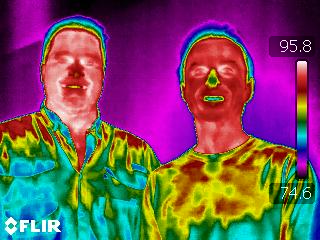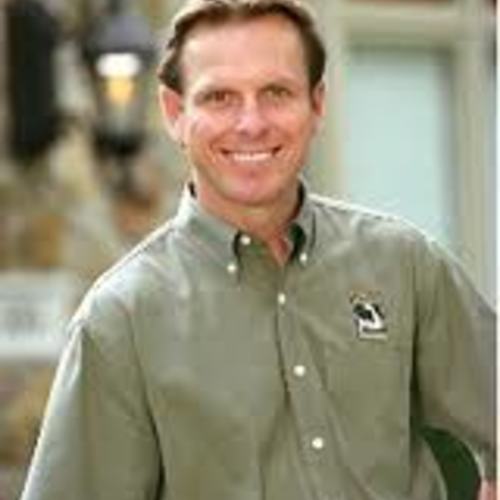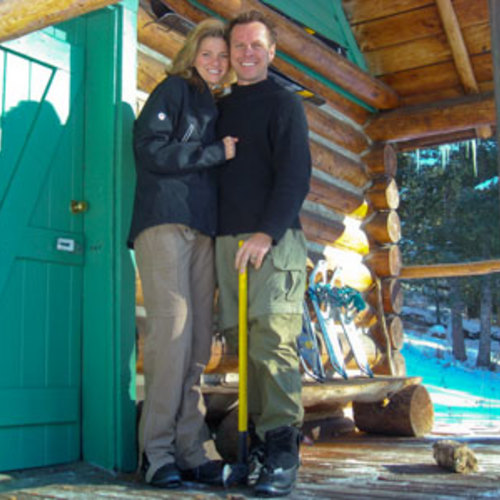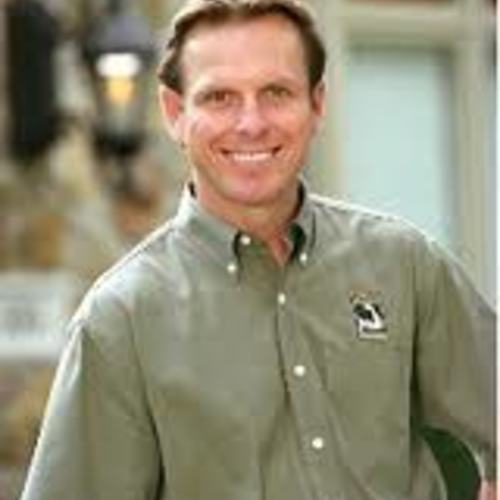
If you think I look silly in the adjacent photo, I am here to warn you that thermographic imagery will make us all look silly if we do not take stock of the power it holds in the hands of homeowners. In the next two to three years, it will change the way we all look—and the way our houses are built—more than ANY other technology to hit our industry since power tools.
The leap from hand tools to power tools was much bigger than the leap from power tools to battery-powered tools—the former being a technological driver of efficiency; the latter, one of convenience. But this new affordable camera technology now gives us Supermanlike X-ray vision to look through walls, floors, and ceilings. And it will undoubtedly reveal some very unpleasant surprises.
The big reveal
At their most basic, these cameras detect subtle changes in heat. This means we can spot water leaking within or into almost any point in the building envelope. We can see every possible type of foundation leak, plumbing leak, roof leak, leaks around windows and doors, or rain-driven moisture that works its way through openings in siding, brick, and stucco. More ominous for those responsible, these cameras also detect missing insulation and leaky ductwork.
Other Blogs in this Series
My 1st CommandmentMy 2nd CommandmentMy 3rd CommandmentMy 4th CommandmentMy 5th CommandmentMy 6th CommandmentMy 7th Commandment
High-performance, responsible green builders, however, have nothing to fear. In fact, if you are one of these builders, you are likely already using such a camera yourself as part of your inspection processes—or you at least welcome anybody who would like to come behind your work to see for themselves.
But if your company is in transition and does not understand or appreciate this technology, you could get yourself in a heap of trouble if you are caught with one of the aforementioned problems. Imagine reading a report and viewing the video that shows your insulation contractor missed the cavity between two studs behind a paneled wall with cabinets—or worse yet, a duct connection that was improperly sealed, and then the homeowner presents you with their electricity bills for the past several months, expecting reimbursement.
It’s one thing if you have this information before the client moves into their new home, but it is another if the technology ends up in the hands of a toxic, unhappy homeowner. They will be able to pick their home—and you—apart!
The bottom line
We all make mistakes, but it is the true professional that owns up to those mistakes and gets them fixed right away. Don’t give anyone the chance to find your mistakes before you do. Get ahead by learning and training in this technology so that you can make all aspects of your homes better. Commandment #7: You can run, but thermography ensures you or your problems cannot hide!
Weekly Newsletter
Get building science and energy efficiency advice, plus special offers, in your inbox.















14 Comments
Construction Management
Michael, I suppose, where repetitive building programs are concerned, I suppose there is no excuse at all - and we should actively be trying to pursue the goals you describe.
I get some entertainment in listening to the CMAA radio from time to time. They do present quite a good discussion, of what to looking for going forward in the industry.
You might like some of the podcasts here:
http://www.cmaanet.org/cmaa-radio
As Built Paper
As-builts – Problems & Proposed Solutions
Stephen R. Pettee, CCM
Abstract
Most, if not all, construction contracts require the contractor to produce as-built drawings. However, little information is found in industry literature about construction as-builts and the asbuilting process. How are they properly executed and to what standards? Who is responsible for the content? How will they be used? The answers to these questions may not be obvious. The construction management (CM) industry should attack the subject in detail. This paper begins the attack by discussing some of the inherent problems in obtaining quality work. It offers some solutions, including the need to develop standards and sharing part of the contractor’s responsibilities in providing them. Specifically, this paper presents three proposals. First, it makes a case for the CM industry to develop general as-built standards that could be used for most construction contracts. Second, it offers a payment vehicle to the contractor for producing them. Finally, it proposes that the construction manager take an active role in the as-builting process.
http://www.cmaanet.org/cm-ejournal
At their most basic, these
Anyone with Level I training in IR will recognize this statement as somewhat optimistic. IR does allow us to identify possible wet areas in building assemblies, given the right conditions. It is of little or no use in identifying moisture problems in other conditions. It is often necessary to use other tools and techniques to further investigate things seen with IR. Anyone considering an IR camera should also consider the training needed to help them use the tool successfully.
As a builder and remodeler, I think IR is fantastic. I have Level I training, own a camera, and use it frequently, but if your job is to conclusively identify building problems (or the lack thereof) I would encourage you to qualify the author's statement carefully.
Contracts for integrated design
An interesing piece on integrated design from CMAA magazine.
http://www.nxtbook.com/ygsreprints/ygs/p14053_tgd_cma/#/20
Cutting corners
Maybe one of these days builders, framers, insulators, etc. will realize that cutting corners will come back to hunt them. I'm surprised that some ambulance chaser hasn't gone around testing homes with a camera and starting class action suits about fraudulent framing, sealing & insulation applications.
Architects & Designers
I guess since I am a designer I should have started with Architects and Designers that need to include all the necessary details to have a complete set of plans. Of course, that contradicts with the $1/s.f. price builders are paying for their plans and the fact the Design Community has sold out to do cheep and incomplete set of drawings.
limited by season
I just had my house blown with dense pac cellulose. I don't have air conditioning so I'll have to wait until the heating season to check how good of a job my contractor performed. I wonder if there is yet another temperature independent sensor technique that might be developed and serve as a diagnostic tool. Some sort of density scan or the like.
I love the opening sentence of this blog. Nice bit of writing.
delta T
What is the average indoor - outdoor temperature difference in your home? If you have 10 degrees you could conduct a reasonably good IR inspection. When the sun hits an exterior wall, that might produce ideal conditions. Generally accepted delta T is 18 degrees but with a good camera you can get by with less, especially if you have a blower door.
It can be difficult to tell whether insulation is missing, the cavity is not completely filled, the insulation is not in contact with the drywall, etc.
response to David
My home was built in 1907 and I am just starting insulation and air tightness measures. Currently the ACH50 is 13+ so I don't imagine much of a delta T can be maintained between the interior and exterior. Maybe direct sunlight on an exterior wall would give a reading but that would still only be one of the four sides of the house.
Is the training really necessary
Can anyone comment on the training they received? I have been thinking about doing it but seems very expensive for what appears to be a pretty simple concept. I've been using our camera for over a year now without any training - red is hot, blue is cold - its not we are looking at the components in rocket ships. What do you think - do you really get anything out of it and is it worth the cost?
J Chesnut
I have examined some very leaky homes and of course you can get adequate delta T. If you can get the house to 68 or 70 degrees early in the morning, and it's 50 outside overnight, you have great conditions. I suppose if you live in San Diego that might never happen, but in a lot of the country it should be fairly easy.
Danny
I took Level I training from the Snell Group, and thought it was very worthwhile. I have 25 years as a builder and had some previous experience with infrared as a volunteer firefighter, but found the class to be engaging all the way through. I do agree that you can probably get some good use out of the technology with no training, but given the chance I would take it. I will probably take Level II next year.
not so limited by season
Oops. An oversight on my part.
I just had dense pac cellulose blown into the cavities of my own home and I can't perform thermography just yet because not only do I have no air conditioning but I'm in the middle of exchanging my heating system so I have no way to heat the house above the outside temperature. Couldn't see past my own particular circumstances.
moisture problems
One effective way to combat moisture is by the use of desiccants like Silica Gel. These are the same small sachets you find in packaging of various products like electronics, garments, etc. Silica Gel works by absorbing the moisture in its surrounding area. For most moisture challenges, does the job. With small sachets cost less than a dollar, it truly is a cost effective way of protection from moisture. There is a lot more information and an order form on our website at http://www.SilicaGel.net
Log in or create an account to post a comment.
Sign up Log in